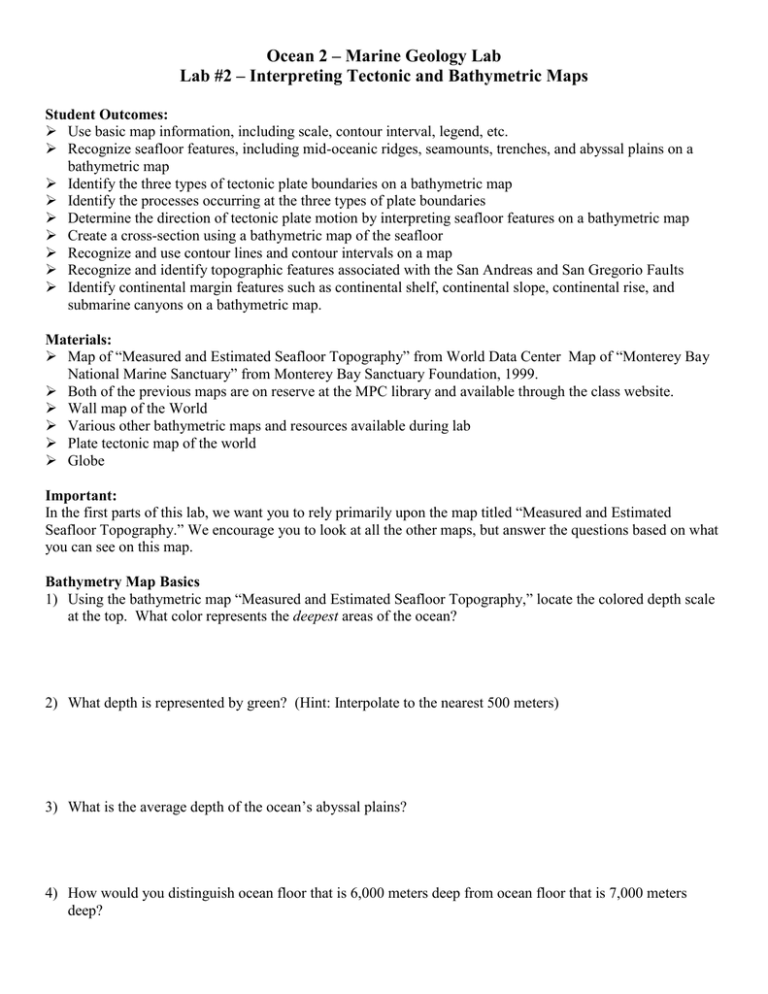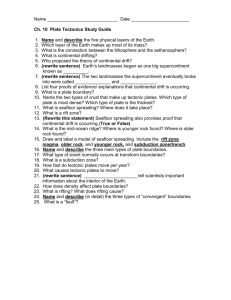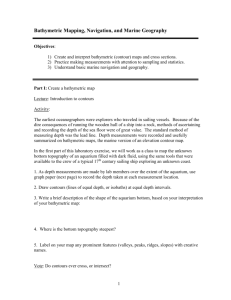Tectonics and the Ocean Floor
advertisement

Ocean 2 – Marine Geology Lab Lab #2 – Interpreting Tectonic and Bathymetric Maps Student Outcomes: Use basic map information, including scale, contour interval, legend, etc. Recognize seafloor features, including mid-oceanic ridges, seamounts, trenches, and abyssal plains on a bathymetric map Identify the three types of tectonic plate boundaries on a bathymetric map Identify the processes occurring at the three types of plate boundaries Determine the direction of tectonic plate motion by interpreting seafloor features on a bathymetric map Create a cross-section using a bathymetric map of the seafloor Recognize and use contour lines and contour intervals on a map Recognize and identify topographic features associated with the San Andreas and San Gregorio Faults Identify continental margin features such as continental shelf, continental slope, continental rise, and submarine canyons on a bathymetric map. Materials: Map of “Measured and Estimated Seafloor Topography” from World Data Center Map of “Monterey Bay National Marine Sanctuary” from Monterey Bay Sanctuary Foundation, 1999. Both of the previous maps are on reserve at the MPC library and available through the class website. Wall map of the World Various other bathymetric maps and resources available during lab Plate tectonic map of the world Globe Important: In the first parts of this lab, we want you to rely primarily upon the map titled “Measured and Estimated Seafloor Topography.” We encourage you to look at all the other maps, but answer the questions based on what you can see on this map. Bathymetry Map Basics 1) Using the bathymetric map “Measured and Estimated Seafloor Topography,” locate the colored depth scale at the top. What color represents the deepest areas of the ocean? 2) What depth is represented by green? (Hint: Interpolate to the nearest 500 meters) 3) What is the average depth of the ocean’s abyssal plains? 4) How would you distinguish ocean floor that is 6,000 meters deep from ocean floor that is 7,000 meters deep? Atlantic Ocean 1) Name at least one place where the Mid-Atlantic Ridge is exposed above sea level. Use the map behind the screen, or any other lab resources, to find place names. 2) Where are the deep, broad abyssal plains of the Atlantic Ocean? a. Describe their location using a relationship to a continent or other widely recognized feature (i.e., “east of South America but west of the Mid-Atlantic Ridge). b. How did you recognize the abyssal plain? What are its defining features? 3) Where are the deepest areas of the Atlantic Ocean? (Hint: Remember the deepest bathymetry is shown by a light purple color, not deep purple or blue.) a. Describe their location using the name of the nearby island chain. See map behind screen for names. b. What is the tectonic setting of these deepest areas? 4) Is the east coast of South America at a plate boundary or in the middle of a plate? How do you know? Indian Ocean 1) Is Madagascar part of the African Plate? Why or why not? (Hint: do you see any plate margin features between Madagascar and continental Africa?) 2) Is Madagascar part of the African continent? Why? Or why not? (Hint: Continental boundaries are defined by the edge of the continental shelf.) 3) India and Australia are both part of the Indo-Australian Plate. Examine the portion of this plate northwest of Australia. What seafloor features are found along the northeast What kind of tectonic boundary is this? boundary of this portion of the Plate? 4) Examine the southwestern boundary of the Indo-Australian Plate. What seafloor features are found along the What kind of tectonic boundary is this? southwest boundary of this portion of the Plate? 5) Considering your observations in answering the previous two questions, what direction do you think the Indo-Australian plate moving? Explain your conclusion. 2 Pacific Ocean 1) Western Boundaries of the Pacific Plate a. What seafloor features do you find along the western boundaries of the Pacific Plate? b. What type of tectonic boundary is this? 2) Southeastern boundary of the Pacific Plate a. What seafloor features do you find along the southeastern boundary of the Pacific Plate? b. What type of tectonic boundary is this? 3) Considering your answers to the previous two questions, what direction do you think the Pacific Plate is moving? Explain your rationale. 4) Locate the Hawaiian-Emperor Seamount Chain. a. Notice the bend in the chain. How might this bend have formed? The age of the rocks at the bend is 43 million years old. b. Why do you think the seamounts become progressively deeper to the north and west of Hawaii (think isostasy)? 5) Where in the Pacific Ocean would you expect to find the oldest oceanic crust? Why? 6) Locate the Marshall Islands and the Louisville Ridge in the southwest Pacific. Notice how the islands and the ridge seem to connect with one another. What do you think happened to the missing islands in between? What feature do you see on the bathymetric map that supports your guess? 3 7) Notice the chain of islands extending north from New Zealand. Why might you expect to find active volcanoes on these islands? What kind of volcanoes would you expect them to be? Explain using what you know about plate boundaries. Cross-sections Using the bathymetric maps in lab as a reference, draw cross-sections along the lines indicated on the map below. Use the lines A-B, C-D, and E-F provided on a following page to draw your cross-sections. (Note that cross-section C-D goes right through Hawaii.) In your cross-sections, be sure to include and label the following features, if present: Lithosphere Hot spots Asthenosphere Trenches Crust Convergent margins Approximate topography and bathymetry Divergent margins Sea level Transform margins Sites of active volcanism Mid-ocean ridges 4 A___________________________________________________________________________________B C___________________________________________________________________________________D E___________________________________________________________________________________F Monterey Bay Area Refer to the map of the Monterey Bay National Marine Sanctuary put out by the Monterey Bay Sanctuary Foundation (1999) to answer the questions in this section. 1) Ask your instructor to show you the San Andreas Fault (SAF) on the map. a. Draw the location of the SAF on the map on the next page. b. In the northernmost part of the map, which bay marks the course of the SAF? c. Near what famous landmark is the SAF located offshore rather than onshore? d. Near what highway does the SAF cross the Pajaro River near Watsonville? e. In the southern portion of the map, which highway follows the SAF most closely? f. What kind of fault is the San Andreas Fault? 2) Note the light blue lines labeled with numbers in the offshore portion of the map. These lines are called contour lines. A contour line is a line joining points of equal elevation, or, in this case, of equal depth. The contour interval is the vertical distance between contour lines. a. Find the map legend. In what units are depths recorded on this map? b. What is the contour interval on this map close to shore? c. What is the contour interval on this map far from shore? 3) The Monterey Bay National Marine Sanctuary map shows several seafloor features exceptionally well, including examples of the continental shelf, continental slope, continental rise, submarine canyons, and seamounts. Label examples of each of these features on the image on a following page. 4) Find the Monterey Fan in the southwestern region of the map. a. If you drilled a hole here, what kind of material would you expect to find? b. How would it have gotten there? c. Where did it come from? 5) How deep is the Monterey Canyon near the intersection with the Carmel Canyon in meters and in feet? (One meter = 3.28 feet) 6) Ask your instructor to show you the trace of the San Gregorio Fault south of San Francisco to the Santa Lucia Range. Draw the location of the San Gregorio Fault in the image on a following page. Remember the bathymetric and the Marine Sanctuary maps are available for your use at the reserve desk at the library. The bathymetric maps are also available on the class website. 7





